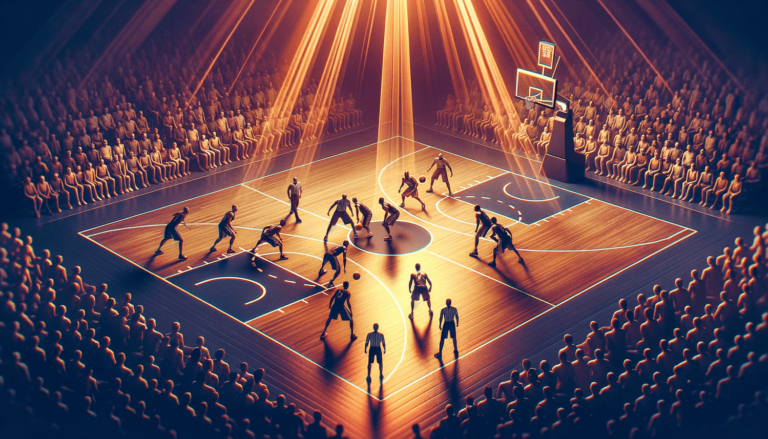
Eight-Second Backcourt Violation Rule in Basketball
Written by: Basketball Universe
Last updated:

In the fast-paced world of basketball, where every second can make or break a game, the eight-second backcourt violation rule plays a crucial role in maintaining the thrill and excitement we all love. Whether you’re a seasoned fan or just beginning your journey into the world of hoops, this blog post is here to provide you with an in-depth understanding of this intriguing rule. So, buckle up as we dive into the world of backcourt violations, exploring its history, significance, and how it has evolved over time to challenge even the most skilled players on the court. Let’s slam dunk our way through the ins and outs of the famous eight-second backcourt violation rule!
Eight-Second Backcourt Violation Rule in Basketball
The eight-second backcourt violation rule in basketball is a regulation that requires the offensive team to advance the ball past the half-court line within eight seconds. Failure to do so results in a loss of possession and a turnover. This rule helps to maintain the pace and excitement of the game, forcing teams to act quickly and efficiently while handling the ball.
The Origins of the Eight-Second Rule
Before we delve into the details of the eight-second backcourt violation rule, it’s important to understand how this intriguing piece of basketball lore came into existence. Basketball as a sport dates back to the 1890s, but the eight-second rule wasn’t formally introduced until the 2001-02 NBA season. This addition to basketball rules was a strategic move designed to further bolster the high-octane drama that spectators and players crave.
Understanding the Territory: Frontcourt and Backcourt
To master the ins and outs of the eight-second rule, one must first grasp the concept of frontcourt and backcourt. For the uninitiated, the basketball court is divided into two equal halves – the frontcourt and the backcourt – by the half-court line. When a team gains possession of the ball in their half of the court, that particular area is referred to as the backcourt. On the other hand, the opponents’ half, where the attacking team aims to score, is called the frontcourt.
The Mechanics of the Eight-Second Rule
Now that you have a basic idea about the court’s layout, let’s delve into the mechanics of the eight-second backcourt violation rule. The clock starts ticking the moment a player from the offensive team touches the ball after it has been inbounded. The team then has eight seconds to move the ball across the half-court line and into the frontcourt. Take note that the eight-second count does not reset if the same team regains possession of the ball in the backcourt after losing it momentarily. In this scenario, the original eight-second count continues.
The Consequences of Violation
So, what happens if a team violates the eight-second rule? A backcourt violation results in the offending team losing possession of the ball, allowing the other team to inbound it from the sideline. This type of turnover not only disappoints the crowd but also hands over a potential scoring opportunity to the opposition.
Common Misconceptions
It’s worth noting that despite its name, the eight-second rule does not always require the offensive team to advance the ball past the half-court line within exactly 8 seconds. There are certain exceptions and circumstances where the offensive team gets a more lenient violation period:
- A new 8-second count may be awarded if the defensive team intentionally deflects the ball out of bounds or causes a held ball in the backcourt.
- If a jump ball is called or a team gets a technical foul while they still have possession in the backcourt, their eight-second count resets.
- Finally, if a shot is attempted before the expiration of the eight seconds and an offensive rebound is collected, the eight-second rule no longer applies, as the offensive team has successfully advanced the ball into the frontcourt.
Impact on Tactics and Gameplay
The inclusion of the eight-second rule has created a significant change in the way basketball players strategize and navigate the court. Coaches and players are now more mindful of the clock, focusing on rapid ball movement and urgency when initiating offense. Here’s how the rule has affected various aspects of the game:
Increased Offensive Pace
The eight-second rule puts teams under additional pressure to execute fast and efficient plays, leading to increased pace, added drama, and more appealing gameplay for spectators. Coaches often design plays and strategies aimed at countering the ticking clock, to ensure their teams do not fall victim to the dreaded backcourt violation.
Importance of Specialist Positions
Point guards, who are responsible for directing a team’s offense, play a crucial role in ensuring that the eight-second rule is not violated. These skilled playmakers need exceptional dribbling, passing and court vision to steer their team’s offensive schemes while consistently maneuvering the ball across the frontcourt in a timely manner.
Enhanced Defensive Pressure
Defensive teams, on the other hand, often employ high-pressure defense tactics in the backcourt to capitalize on the stress imposed by the eight-second rule. By applying aggressive pressure on the ball handler and impeding passing lanes, they force mistakes, rushed decisions, and, at times, successfully provoke backcourt violations.
Eight-Second Rule Across Different Leagues
While the eight-second rule is most closely associated with the NBA, its presence is felt across various basketball leagues worldwide. Although the specific rules and regulations might vary, the core principle remains the same – the offensive team has a limited amount of time to cross the half-court line:
FIBA and International Play
The International Basketball Federation (FIBA) also enforces an eight-second backcourt violation rule in international competitions, such as the World Cup and the Olympics. This rule aligns with the NBA’s regulations, ensuring consistency and excitement across professional leagues and international events.
WNBA and Women’s College Basketball
The eight-second rule not only applies to men’s professional leagues but also to women’s basketball. The Women’s National Basketball Association (WNBA) and NCAA Women’s Basketball both follow the eight-second backcourt violation rule, emphasizing consistent pacing and excitement in both men’s and women’s games.
NCAA Men’s Basketball
In NCAA Men’s Basketball, however, the regulation is slightly different. While they also enforce a time constraint on advancing the ball past the half-court line, the rule stands as a 10-second violation instead of the eight-second rule used in other leagues. Nonetheless, the spirit and purpose of the rule remain constant, ensuring that the game’s tempo and excitement are maintained.
Conclusion
The eight-second backcourt violation rule has become an essential part of modern basketball, driving intensity, and competitiveness while maintaining the type of fast-paced gameplay that fans adore. By understanding the fundamentals and nuances of this critical rule, you will gain a heightened appreciation for the strategies employed by players and coaches and deepen your overall love for the sport. So, the next time you catch a game, keep an eye out for the eight-second rule in action, and revel in the thrilling atmosphere that it helps to create.
A Deeper Look at Backcourt Exception Cases
As mentioned earlier in our journey through the eight-second backcourt violation rule, there are some exceptions and case-by-case scenarios that may alter how the rule is enforced. Diving deeper into these specific instances will provide a more comprehensive understanding of the eight-second rule’s intricacies.
Shot Clock Violation vs. Eight-Second Backcourt Violation
While both types of violations are related to time constraints, it’s important to distinguish between a shot clock violation and an eight-second backcourt violation. A shot clock violation occurs when a team fails to attempt a shot within the designated time frame (24 seconds in the NBA and FIBA, 30 seconds in men’s and women’s NCAA basketball). In this case, a team must not only advance the ball into the frontcourt but also execute a shot attempt within the allotted time frame. Confusing the two violations is common but understanding their differences could enhance your general basketball knowledge.
Last-Second Backcourt Possessions
There are certain situations in which a team will be allowed extra time to get the ball across half-court. If a team gains possession with less than eight seconds remaining on the game clock, they do not have to worry about the eight-second backcourt violation rule. While the rule is generally consistent, this scenario ensures that games end on a high note rather than a technical violation.
Critical Skills to Avoid Eight-Second Violations
To thrive under the pressure of the eight-second backcourt violation rule, players must develop valuable skills that can help their team avoid costly turnovers. Here are some essential skills a player can nurture to prevent violations:
Effective Ball-Handling
As a prerequisite to becoming an elite basketball player, mastering the art of ball-handling is crucial. Players who can effortlessly dribble, change direction, and make precise passes under pressure are less likely to succumb to the eight-second rule, ensuring that their team’s offense runs smoothly.
Strong Team Communication
Effective communication and coordination amongst teammates are vital in avoiding eight-second backcourt violations. A well-connected team knows how to interpret their fellow players’ movements, predict plays, and execute seamless passes under pressure, which can minimize mishaps and enhance overall gameplay.
Reading Defensive Schemes
Players who can quickly dissect an opposing team’s defensive strategies are less likely to be flustered by backcourt pressure. By identifying defensive patterns and potential weaknesses, a player can make smarter decisions on the court, helping their team swiftly move the ball into the frontcourt without risking a violation.
Additional Tips for Spectators and Fans
As an avid basketball fan, knowing the nuances of the eight-second backcourt violation rule can greatly enhance your viewing experience. To get the most out of watching a game, consider these extra tips:
Pay Attention to the Referees
Referees serve as the ultimate authorities on the enforcement of the eight-second rule. Keeping a watchful eye on officials during games helps viewers better understand the intricacies of the rule and other regulations, ensuring an exciting and engaging viewing experience.
Tune into the Commentators
Basketball commentators often relay insightful information about tactics, timings, and rule updates that inform the listening audience. Paying attention to their analysis and commentary during games can offer a deeper understanding of the eight-second backcourt violation rule and its impact on the game.
Engage in Conversations
Discussing basketball rules, gameplay, and strategies with fellow fans and friends can broaden your perspective, increase your understanding of the game, and spark engaging conversations. Being open to sharing and learning from others’ experiences and insights can ultimately enhance your overall enjoyment of basketball.
In understanding and appreciating the complexities of the eight-second backcourt violation rule, you not only embrace the heart of basketball but also cultivate a deeper love and respect for the sport. So, the next time you tune into a game, keep the rule’s fascinating aspects in mind, and don’t hesitate to share your expertise with fellow fans.
FAQ Section: Eight-Second Backcourt Violation Rule
In this section, we’ll explore some frequently asked questions related to the eight-second backcourt violation rule. From technical queries to strategic implications, these FAQs will provide you with quick and concise answers to deepen your understanding of this essential basketball rule.
1. What happens when a team commits an eight-second backcourt violation?
When a team commits an eight-second backcourt violation, they lose possession of the ball. The opposing team then gains possession and inbounds the ball from the sideline near the half-court line.
2. Does the eight-second rule apply in all leagues?
The eight-second rule applies in various leagues, including the NBA, FIBA, and WNBA. However, in NCAA Men’s Basketball, the rule is slightly different, with a 10-second violation instead of 8 seconds.
3. How does the eight-second rule influence the pace of the game?
The rule forces teams to act quickly and efficiently, leading to an increased pace and urgency to advance the ball from the backcourt to the frontcourt. This higher-tempo gameplay is more exciting for spectators and players alike.
4. How can a player avoid committing an eight-second backcourt violation?
To avoid committing this violation, a player should focus on strong ball-handling skills, effective communication with teammates, swift decision-making under pressure, and the ability to read defensive schemes.
5. Can the eight-second count be reset during a play?
Yes, the eight-second count may be reset in some specific scenarios, such as when the defensive team intentionally deflects the ball out of bounds or causes a held ball in the backcourt. A new count may also be awarded if a jump ball is called or if the team gets a technical foul while still in the backcourt.
6. Does the eight-second rule apply if there are less than eight seconds left on the game clock?
If a team gains possession with less than eight seconds remaining on the game clock, they do not have to worry about the eight-second backcourt violation rule. The idea is to create a thrilling finish for both teams and the fans.
7. Can a team be called for both an eight-second backcourt violation and a shot clock violation on the same play?
No, a team cannot be called for both violations simultaneously. If a team commits an eight-second backcourt violation, they lose possession before a shot clock violation can occur.
8. What happens if the defensive team interferes with the ball in the backcourt?
If the defensive team interferes with the ball, a new eight-second count is awarded to the offensive team. However, the offensive team must still watch for potential shot clock violations.
9. How does the eight-second rule differ between various basketball leagues?
The core principle of the rule remains the same across most leagues, but the specific time constraints may vary. For example, the NCAA Men’s Basketball employs a 10-second violation instead of an eight-second violation. Otherwise, the impact and purpose of the rule are consistent across leagues.
10. Are there any other time-related violations in basketball?
Yes, other time-related violations include the shot clock violation, three-second violation, and the five-second inbound violation. Each violation has its unique constraints and consequences, contributing to the overall intensity and competitiveness of the sport.
Featured Posts
- No pillar pages found.





